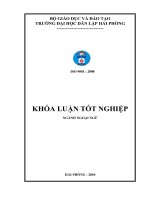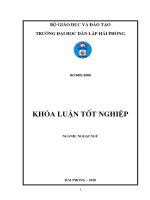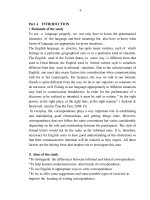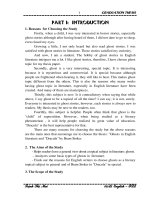TOPIC 69 English stereotypes and music
Bạn đang xem bản rút gọn của tài liệu. Xem và tải ngay bản đầy đủ của tài liệu tại đây (84.76 KB, 13 trang )
69: SOCIETY & CULTURE. STEREOTYPES & EMBLEMS OF
ENGLISH SPEAKING COUNTRIES. THE CULTURAL INFLUENCE
OF SONGS IN ENGLISH
This topic is going to focus on two aspects of the society and culture of
some English speaking countries. Firstly, I will deal with stereotypes and
emblems and then I will move on to a discussion about English songs as
vehicle for cultural influence. As it is impossible to deal here with all the English
speaking countries, I will focus my attention on two of the most important ones:
the British Isles and the United States.
But before I go any further I’d like to mention the bibliography I’ve used in order
to develop this topic:
Bromhead, Peter. 1962. Life in Modern Britain. Longman.
- Council of Europe (1998) Modern Languages: Learning, Teaching,
Assessment. A Common European Framework
of reference.
- McLean, A. 1993. Profile UK. Heinemann, Oxford.
- Vaughan-Rees, M. 1995. In Britain. Richmond Publishing Editors.
I will begin with the British Isles. To begin with, I would like to make some
considerations about the British Isles. The British Isles have always been
culturally and ethnically diverse. There are many differences between the four
nations of England, Wales, Ireland and Scotland, and distinctive ways of life
within each country. The history of the British Isles before the 18 th century is not
about a single British identity or political entity: it is about four different nations
and their peoples, who have often been hostile towards one another. Political
terms like ‘British’ and ‘Britain’ can therefore seem artificial to many of the
1
peoples who comprise the present UK population and who have retained their
individual cultural and national identities. Foreigners often call all British people
‘English’ and sometimes have difficulties in appreciating the distinctions, or the
annoyance of the non-English population at such labelling.
The Scots, Welsh and Northern Irish are largely Celtic peoples, while the
English are mainly Anglo-Saxon in origin. There has obviously been racial and
cultural intermixture in Britain over the centuries, which resulted from adaptation
by immigrant groups and internal migration between the four nations. British
identification however has often been equated with English norms for various
reasons, among them that state power is concentrated in London and that the
English dominate numerically. The Scots, Irish and Welsh have always been
very aware of the difference between their nationalism and Britishness; they
resent the English dominance, see themselves as very different to the English;
and regard their nationalist and cultural feelings as crucial. There are also
differences to be found within the four nations. The English themselves react
against London influences, and there are some demands for de-centralised
political autonomy service. They are a relatively mixed people, and local
identification is still strong. The Cornish, for example, see themselves as a
distinctive cultural element in English society, and the northern English have
long regarded themselves as superior to the southern English and vice versa.
The Scots generally unite in defence of their national identity and
distinctiveness because of historical reaction to the English. They are conscious
of their traditions, which are reflected in cultural festivals and different legal
religious and
educational
systems. There
is
resentment
against
the
2
centralisation of political power in London and the alleged economic neglect of
Scotland (although the British government provides greater economic subsidies
per head of population to Scotland and Wales than to England). Scots are,
however, divided by 3 languages (Gaelic, Scots and English), different regions,
prejudices and regionalisms. Cultural differences separate Highlanders and
Lowlanders, and deep rivalries exist between the major cities of Edinburgh and
Glasgow.
All these features suggest that the contemporary British are a very
diverse people, particularly when original settlement has been added to by
centuries of later immigration. It is consequently as difficult to find a typical
English, Welsh, Scottish and Irish person who conforms to all or even some of
the assumed national stereotypes, as it is to find a typical Briton. Sometimes,
however, the four nations do employ national stereotypes. The English like to
see themselves as calm, reasonable, patient and commonsensical people, who
should be distinguished from the excitable, romantic and impulsive Celts. The
Celts on the other hand, may consider the English to be arrogant, patronising
and cold, and themselves having all the virtues.
Once I have explained what the situation in Britain is, I am going to
concentrate on the stereotypes most often applied to the British peoples. The
British, like the people of every country, tend to be attributed with certain
characteristics which are supposedly typical. However, it is best to be cautious
about accepting characterizations too quickly. Societies change over time while
reputations lag behind. Many things which are often regarded as typically British
derive from books, songs or plays which were written a long time ago and which
3
are no longer representative of modern life. One example of this is the popular
belief that Britain is a ‘land of tradition’. This is what most tourist brochures
claim. This claim is based on what can be seen in public life. And at the level of
public life, this is true; take for instance the annual ceremony of the state
opening of Parliament or the changing of the guard outside Buckingham Palace,
which have remained so for centuries. This reputation for tradition can lead to
its artificial preservation or even its re-introduction. A notable example is the
Asquith taxi, introduced in 1994 as an exact replica of London taxis of the 1930s
and deliberately designed that way to appeal to tourists, who equate London
with tradition. Similarly, when London’s famous red buses were privatized in the
early 1990s, the different bus companies wanted to paint their buses in their
company colours. The government ruled that all buses had to stay red because
that is what would help the tourist trade. Even today, although most of the
traditional double-decker buses have disappeared, buses remain red.
However, in their private everyday lives, the British as individuals are
probably less inclined to follow tradition than are the people of most other
countries. There are very few ancient customs that are followed by the majority
of families on special occasions. The country has fewer local parades and
processions with genuine folk roots than other countries, and the English
language has fewer sayings or proverbs that are in common everyday use than
many other languages do. In addition, it should be noted that the British are the
most enthusiastic video-watching people in the world –the very opposite of a
traditional pastime.
4
There are many examples of supposedly typical British habits which are
not typical any more. For example, the stereotyped image of the London ‘city
gent’ includes the wearing of a bowler hat. In fact, this type of hat has not been
commonly worn for a long time. Food and drink provide other examples. The
traditional British breakfast is a large ‘fry-up’ preceded by cereal with milk and
followed by toast, butter and marmalade, all washed down with lots of tea. In
fact, only about 10% of the people actually have this sort of breakfast. Two-thirds
have cut out the fry-up and just have the cereal, tea and toast. The rest have
even less. Of course, we cannot forget the image of England as a nation of teadrinkers, which, nowadays, is somewhat out of date. It is true that tea is still
prepared in a distinctive way (strong and with milk), but today, more coffee than
tea is bought in the country’s shops. As for the tradition of afternoon tea with
biscuits, scones, sandwiches or cake, this is a minority activity, confined to
retired people and the leisured upper-middle class.
Even when a British habit conforms to the stereotype, the wrong
conclusions can sometimes be drawn from it. The supposed British love for
queuing is an example. Yes, British people form queues whenever they are
waiting for something, but this does not mean that they enjoy it. In 1992 a survey
found that the average wait to pay in a British supermarket was three minutes
and twenty-three seconds, and that the average wait to be served in a bank was
two minutes and thirty-three seconds. You might think that these times sound
very reasonable. But The Sunday Times did not think so and referred to those
figures as a problem. Some banks promised to serve their costumer within two
minutes. This demonstrate that the British do not like queuing, and in fact, during
5
the rush hour, when a bus or a train arrives, people often push forward to make
sure they get on. This is called jumping the queue!
Other stereotypes about the English are that they are always cold and
have a posh voice; that they talk about cricket, about the colonial empire…but
never about sex! And that they always arrive on time thanks to the British
punctuality! However, sometimes the reality is quite different. The British have a
reputation for politeness; if you do not hold the door open for somebody, people
will think that you are rude, but British football supporters have a reputation for
violence. Another example is that British people love animals… but they still go
fox-hunting! And a final stereotype which is true: they are always talking about
the weather! The weather is a very convenient topic with which to “fill the gap”,
as asking personal questions or remaining silent might be rude.
Now, let me take a look at the three remaining nations. Scottish people
are thought to be always drunk and wearing a kilt with the bagpipes. Moreover,
they are famous for their selfishness, and for being very careful with money.
People think that the Welsh only speak about sheep and that they always wear
a woollen pullover or a red rugby top and that is likely to have a leek or daffodil
about his person. Moreover, they are thought to be the whole time singing
‘Delilah’ by their idol, Tom Jones. Finally, the Irish are reported to be very
friendly and great talkers. In every British joke, the unintelligent one is always
the Irishman. People associate the Irish with the harp and wearing something
green, featuring a shamrock, the national emblem. Like the Scottish, they had a
bit of reputation for liking whisky, about all, for liking beer called ‘Guinness’.
6
After dealing with the stereotypes associated with the British people, I am
going to deal with those associated to the Americans. It is important to take
into account that the US is a huge country with very distinct state realities. For
this reason, it is difficult to make generalizations about its population. Every
state has its own peculiarities and associated stereotypes. The US is
traditionally divided into five regions. New Englanders, in the North-east, are
sometimes called true Yankees and are proud of their history. People living in
the East coast, in cities such as New York, Baltimore or Washington, are
thought to have a fast and aggressive lifestyle. The states of the Midwest are
thought to be conservative and to have old-fashioned ways and a great concern
for family values and religion, with the exceptions of Chicago and Detroit, which
are thought of as liberal. People from the South are traditionally very religious.
The hot climate means that they have a slower lifestyle, so other Americans
sometimes think southerners are lazy. Finally, the West is considered to be the
land of opportunities and a place of new beginnings.
Despite the differences, there are stereotypes associated to American
people. They are thought to talk in a very loud voice, starting every sentence
with “gee…” and complimenting everyone on anything. There are two images
associated to Americans: either the well-built person as handsome as a movie
star or the American tourist. The average American tourist man appears to be
middle-aged, wealthy, and wearing a colourful shirt or checked pants. He is fat,
because of the unhealthy foods, and friendly. His wife has permed hair and
wears little white socks, trainers and pants. Another typical American image is
that of the Texan, wearing jeans and cowboy boots, and with the Cadillac
7
parked outside. They are said to be strong defendant and supporters of
everything American.
There are other common stereotypes associated to the US. For instance,
everything there is much bigger than in any other place; American cities are so
dangerous that a person has a good chance of being killed in the street;
therefore, American men either know kung-fu or carry a gun; Americans eat
almost nothing but hamburgers, hot dogs, popcorn, and Coke, and so on. Today
it is difficult to meet these stereotypes. The practice of stereotyping, apart from
amusing, is quite useful in story telling. In this sense, the film industry is a
frequent user of it.
As can be seen, stereotypes prove a frequent phenomenon, the dangers
of which should not be underestimated, the same as its frequently negative
nature.
After the discussion about stereotypes I am going to move on to deal with
emblems. The OED, describes an emblem as “a visible object or representation
that symbolises a quality, type, group, etc”. Firstly, I will focus my attention on
the British Isles. In Wales, the national emblem is the leek. It is said that it
became the national emblem following an ancient victory by an army of
Welshmen who wore leeks as a distinguishing sign. So it has historical
significance. The harp is also considered an emblem of this country. In
Scotland, the thistle is the emblem, also with historical significance. According
to a story, a group of Scottish clansmen were saved from annihilation by
patches of thistle preventing the attack of the barefooted Vikings. On the other
hand, the prickly-leafed purple flower is a symbol of defence and nowadays, it is
8
widely used to signify the “Scottishness” of countless products, services and
organizations. Moreover, a tartan pattern is used on many products made in
Scotland. The national emblem of England is the rose, adopted as the emblem
since the War of the Roses: the civil wars (1455-1485) between the royal house
of Lancaster and the royal house of York. The emblem of the Lancastrians – a
red rose- and the emblem of the Yorks – a white rose- were united in the Tudor
rose – a red rose with a white centre- when Henry VII married Elizabeth of York,
ending so the civil wars. The rose symbolised the union of these royal houses.
Another English emblem is the dragon, remembering that the patron saint of
England is Saint George, who rescued the hapless maiden 1 way back in the 6th
century from the fire-breathing dragon. Chivalry, romance and bravery are
characteristics shown by this emblem. Other emblems include a bulldog, often
wearing a Union Jack waistcoat, and John Bull, an old-fashioned, fat country
gentleman. The national emblem of both Northern Ireland and the Republic of
Ireland is the shamrock; a clover like plant, with 3 leaves. The symbolism of the
shamrock is a religious one, since it is said to have been used by St. Patrick to
illustrate the doctrine of the Holy Trinity. The harp is also considered an emblem
of this country.
Regarding the US, emblems are used to symbolize and signify attributes
of which a nation is proud, and the US eagle is no exception. Chosen no doubt
for its strength, courage and high flight, the emblem graces the front of every
US dollar, a trademark of power that can be traced back to an imperial symbol
of Rome. Each US state has a variety of emblems, including animals and plants
1
‘the hapless maiden’ is a set term often used to refer to the doomed, helpless woman in many fairy tales
who waits until the prince or ‘knight in shinning’ armour rescues her.
9
which are commonly found in that state. These symbols appear on the state flag
and on state documents.
After explaining the different stereotypes and emblems associated to
Britain and the US, I am going to deal with the last part of my topic: English
songs as vehicle of cultural influence. In this section of the topic, I am going to
consider how songs in English have served to spread the culture of the
countries in which they were written and produced across the world.
Music is perhaps the main vehicle of mass communication for the
younger generations; they enjoy the music, sing the songs, copy the dress, and
identify with the attitudes and actions of their favourite singers and groups.
Since the 1950s, alongside the new sounds, dress codes and cultural
variations, a whole new language has developed which has become part of the
everyday vocabulary of millions of teenagers and young people all over the
world.
The roots of today’s pop music lie in America’s deep South, the birthplace
of the blues. During the early 1950s, many white teenagers heard this exciting
new music played by black artists such as Ray Charles or Little Richard. There
was an immediate reaction from the Establishment, with the press and
broadcast media condemning the fact that dirty black music was corrupting pure
white ears. Middle-class white parents feared for their children – especially
perhaps for their daughters, who were becoming mesmerised by the sexual
energy and hypnotic beat of black rhythm and blues. The white radio stations
and record producers could not cash in on this exciting new phenomenon until
10
they could find a white artist to play the music, and this happened in the midfifties, when Sam Phillips, the founder of Sun Records, walked into his studio to
hear a certain Elvis Presley sing and instantly recognised that this was the
person he was looking for: a young, good-looking, white southern male singer
with a black, blues black-ground singing, a hot white version of black music
would be the perfect cross-over artist, a way of making black-inspired music
acceptable and so selling it to the waiting, white market.
Between 1956 and ’58, record sales quadrupled across the States –
thanks to the new craze of black music in white clothing with a new name: rock
’n’ roll. Soon the new sound crossed the Atlantic and British bands started
emulating their American cousins. The Yardbirds, one of the most influential
British groups of the 60s, were led by a guitarist who was to become one of the
most famous blues-inspired British artists: Eric Clapton. Many other groups
followed in the Yardbirds’ footsteps as the years passed, among them a young
band called the Animals, with their famous song ‘The House of the Rising Sun’.
We cannot forget one of the most famous and influential groups of all decades:
The Beatles. In Liverpool (1957) John Lennon asked Paul McCartney to join his
rock ‘n’ roll-inspired band, the Quarry-men. This band became The Beatles in
1960. Their new sound swept the country, and everybody was dancing to the
Mersey Sound. When British radio and infant television became interested in
the new sound, the spirit of youth rebellion began to infiltrate the media. In the
same period, another English group began to appear when Brian Jones met
Mick Jagger and Keith Richards and formed the Rolling Stones. The Stones
crossed the Atlantic early on in their career, without having had a top ten hit
record previously, but at the time there was a white audience in the states that
11
had never heard their music before and yet, being familiar with the blues, the
roots of the Stones’ musical style, they could easily understand where it came
from and also feel excited by its fresh, vibrant energy. Suddenly, white British
bands were crossing the Atlantic, becoming successful with the American
public.
By 1967 the drug-taking hippy movement had taken hold, particularly in
San Francisco. The younger generation thrilled to the sense of the community
that the hippy movement gave them, all dancing in total freedom, dressing any
way they pleased, and all convinced that, now, anything was possible.
Hundreds of thousands of young people gathered for the massive music
festivals, LSD, love and psychedelic experiences. This success soon spread to
the young people of countries all over the world and the new songs became a
vehicle of culture influencing thought, attitudes and actions of the young
generation from one side of the globe to the other.
The vibrant energy of this period continued to be reflected in music as it
developed over the decades to the present day. It was in the Nashville sound
typified by Crosby, Stills, Nash and Young; it was there in the euphoric guitar
solos devised by Jimmy Hendrix; it was there in rap, in house, in jungle, and in
all music and songs played by young people that rely on energy and rhythm for
their appeal. Much popular modern music then has its roots in rock ‘n’ roll which
in turn had its roots in the blues. Therefore, we can say that since the 1950s,
music, and particularly songs in English, has been the main vehicle of mass
communication and of cultural influence for the younger generation all over the
world.
12
Taking all this into account it could be assessed that throughout history,
music has always been credited with the capacity to reflect and influence
human emotion. This capacity has been exploited to a greater extent by popular
culture, by communication methods such as radio, film and television. In the
history of popular music, the capacity to influence and persuade has often been
associated with movements, frequently related to political or popular struggle.
The texts of songs are often highly emotional and often deal with ‘protest’
themes. Take for instance, Britain in the late 1960s when it witnessed the rise in
popularity of the punk movement with groups such as The Clash and The Sex
Pistols, using music as the expression and ‘sign’ of their unwillingness to
conform to society’s rules. The use of lyrics in pop songs is frequently used as a
means of expression, as opposition or in order to highlight some perceived
wrongdoings in the world, such as U2, which used their lyrics to denounce the
British government’s action in the Bloody Sunday demonstrations in Ireland.
To sum up, this topic has dealt with several aspects of the culture and
society of the British Isles and the US: stereotypes and emblems; and the
influence of the English song as a vehicle for cultural influence. The vast culture
of the English-speaking countries makes it difficult to deal with these aspects in
depth. However, I have given an overview and have summarized the most
remarkable features related to stereotypes, emblems and songs in these
countries.
13









